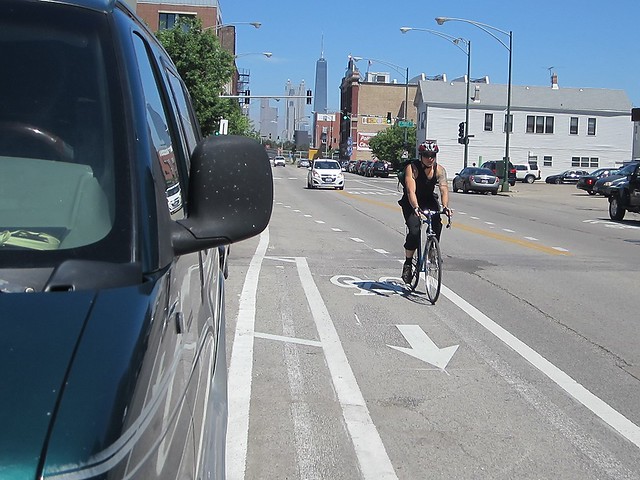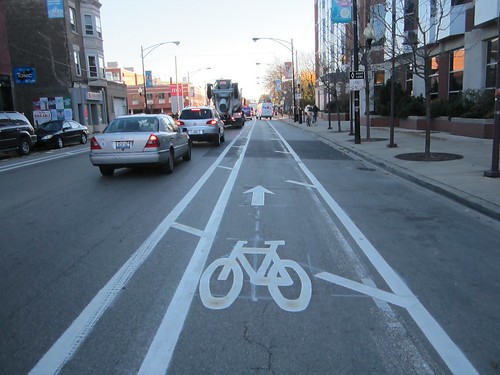What's the best street design to keep bicyclists safely out of the door zone? A buffered bike lane beats a conventional bike lane or "wide curb lane" according to a recent study published in TRB, based on observations in Chicago and Cambridge, Mass.
"Dooring", whereby the bicyclist rides too close to a parked vehicle and becomes vulnerable to crashing should a car door be flung open, can be avoided by biking a safe four feet away from the parked vehicle, but that's easier said than done, particularly on narrow "curb" lanes. But new research shows that even when riding in standard bikes lanes or wide curb lanes, the vast majority of cyclists continue to bike in the door zone.

WIDE CURB LANE
"A wide curb lane is the traffic lane next to the curb (the right most lane) which is extra wide so a motorist can safely pass a bicyclist without having to change lanes. There is no line painted on the street separating motorists from the bicyclists. [Image and text courtesy of Bike Madison, Wis.]"
The study [PDF] by the National Cooperative Highway Research Program (NCHRP) of the Transportation Research Board (TRB) "concludes that wider but un-buffered bike lanes aren’t necessarily better than narrower lanes in encouraging bicyclists to ride outside the door zone," writes Steven Vance.
A bar graph showing various widths of bike lanes, from four to six feet, reveals that less than 10 percent of cyclists rode outside of the door zone according to observations on Clark St., Chicago. However, with a two foot buffered striped zone separating the bike lane from the parked cars, the number of bicyclists riding safely jumped to 40 percent. Presumably the percentage would be greater with a wider buffer lane.

A buffered bike lane does a better job of encouraging bicyclists to ride outside the door zone than a wide bike lane. Photo: John Greenfield
According to the National Association of City Transportation Officials (NACTO), "Buffered bike lanes are conventional bicycle lanes paired with a designated buffer space separating the bicycle lane from the adjacent motor vehicle travel lane and/or parking lane."
"Chicago has been installing protected and buffered bike lanes across the city, and adding buffers to many conventional lanes," writes Vance.
If there’s enough space to make a wider bike lane, the authors conclude, that extra space should be used to install a “narrower bicycle lane with a parking-side buffer,” which “provides distinct advantages over a wider bike lane with no buffer.”
As the NACTO definition indicates, the buffer can also be placed between the curb lane and the bike lane, in lieu of or in addition to the parking lane, as shown in this Chicago photo, also by John Greenfield.
Looking south on Halsted, north of Fullerton. Photo: John Greenfield
FULL STORY: Study: To Keep Bicyclists Outside the Door Zone, You Need a Buffer

Planetizen Federal Action Tracker
A weekly monitor of how Trump’s orders and actions are impacting planners and planning in America.

Chicago’s Ghost Rails
Just beneath the surface of the modern city lie the remnants of its expansive early 20th-century streetcar system.

Amtrak Cutting Jobs, Funding to High-Speed Rail
The agency plans to cut 10 percent of its workforce and has confirmed it will not fund new high-speed rail projects.

Ohio Forces Data Centers to Prepay for Power
Utilities are calling on states to hold data center operators responsible for new energy demands to prevent leaving consumers on the hook for their bills.

MARTA CEO Steps Down Amid Citizenship Concerns
MARTA’s board announced Thursday that its chief, who is from Canada, is resigning due to questions about his immigration status.

Silicon Valley ‘Bike Superhighway’ Awarded $14M State Grant
A Caltrans grant brings the 10-mile Central Bikeway project connecting Santa Clara and East San Jose closer to fruition.
Urban Design for Planners 1: Software Tools
This six-course series explores essential urban design concepts using open source software and equips planners with the tools they need to participate fully in the urban design process.
Planning for Universal Design
Learn the tools for implementing Universal Design in planning regulations.
Caltrans
City of Fort Worth
Mpact (founded as Rail~Volution)
City of Camden Redevelopment Agency
City of Astoria
City of Portland
City of Laramie






























